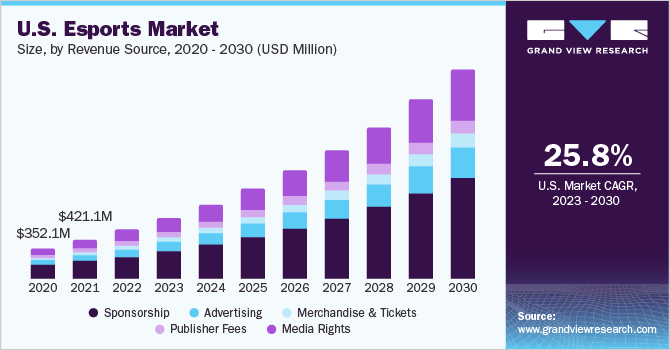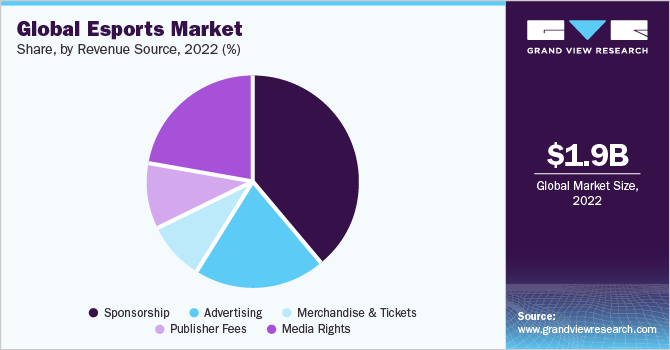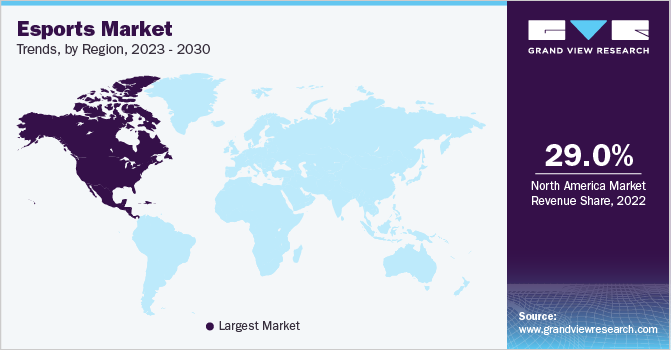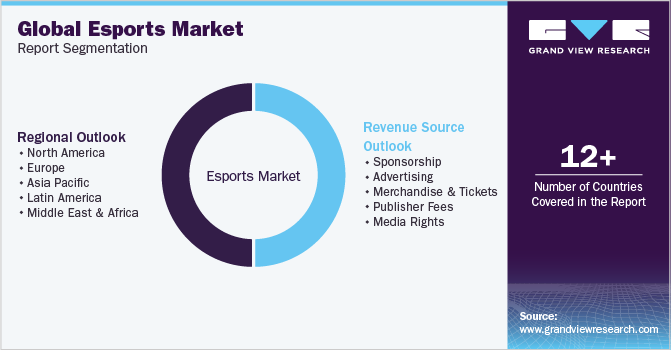- Home
- »
- Next Generation Technologies
- »
-
Esports Market Size, Share, Growth & Trends Report, 2030GVR Report cover
![Esports Market Size, Share & Trends Report]()
Esports Market Size, Share & Trends Analysis Report By Revenue Source (Sponsorship, Advertising, Merchandise & Tickets, Media Rights), By Region (APAC, CSA, Europe), And Segment Forecasts, 2023 - 2030
- Report ID: GVR-4-68038-647-9
- Number of Report Pages: 171
- Format: PDF, Horizon Databook
- Historical Range: 2018 - 2021
- Forecast Period: 2023 - 2030
- Industry: Technology
Report Overview
The global esports market size was valued at USD 1.88 billion in 2022 and is expected to grow at a compound annual growth rate (CAGR) of 26.8% from 2023 to 2030. Increasing live streaming of games, formidable investments, rising audience reach, engagement activities, and infrastructure for league tournaments are the factors influencing market growth. The profitable opportunities created by increasing professionalization in the industry for influencers, gamers, event organizers, and game developers benefit the market. Millennials consider esports a professional career option, owing to the increasing popularity of gaming tournaments, one-to-one sponsorships, streaming revenues, and impressive international prize pools. Additionally, colleges and universities have started providing dedicated esports programs to develop skilled professionals.

Ohio State University, Becker College in Massachusetts, and Virginia's Shenandoah University provide the esports degree course. Additionally, more than 100 high schools in the U.S. are conducting esports programs and other games such as traditional soccer. Some institutes are also providing scholarships to the players to increase the growth of the course; theUniversity of California Irvine is giving scholarships to the top 6 players.
Fewer organizations and limited tournament infrastructure resulted in more minor revenue streams for teams and players and restricted the market growth. However,Riot Games formed the League of Legends for the Europe and North America region, providing an organized format for the tournament. Later, Activision Blizzard, Inc. introduced the overwatch league, providing essential infrastructure and revenue for the esports competitions.Hence, the league model in the tournaments has established numerous revenue sources for the esports ecosystem, promoting overall industry growth.
Dota2, Fortnite, League of Legends, Counterstrike: Overwatch, and Global Offensive are the gaming industry leaders. The video gaming industry has evolved from a hobby to a professional career option. The tournaments are attracting investors, including celebrities and international brands, as sponsors due to the immense engagement of fans for esports tournaments.
Over the past few years, increasing views and fan base have created new growth avenues and resulted in increased investment. In recent years, investments in this industry have made considerable progress as the ecosystem provides various investment options across various subsectors. The market mainly attracts traditional venture capital firms, strategic investors, and private equity. The free-to-play gaming model has been found effective, with considerable in-game microtransactions fueling the companies' revenue, consequently supporting the industry growth. The games in the free-to-play gaming model have become popular as they have no upfront costs, and the fees are charged for featured or additional content. Counter-Strike: Global Offensive, League of Legends, and Fortnite are some games that feature microtransactions. The free-to-play model has promoted diversity and helped to bring young gamers together in the esports ecosystem resulting in the growth of the overall gaming population. Microtransactions have played a crucial role in the market, ensuring the overall revenue growth of the market.
The COVID-19 health crisis has affected multiple elements of human lives and has affected various business sectors. Various leagues and tournaments were postponed and canceled owing to COVID-19. Some organizers hosted the event on virtual platforms as the stadiums were closed. In COVID-19, 8% of live events were canceled, 53% of events were shifted to virtual platforms, 26% of events were rescheduled, and 13% of events remained on schedule. The market experienced moderate growth under all these circumstances in 2020. For instance, EPICENTER Major 2020, Combo Breaker, the Pokémon Championship Series, and many other tournaments scheduled between March and May are canceled. The cancellation of events affected ticket sales and merchandising, resulting in a downward trend in the first half of 2020. Several other tournaments were postponed, such as ESL Americas Pro League, California Overwatch League, ESL One Rio 2020 Counter-Strike, and others. Most of the events shifted to online mode due to lockdowns and quarantine, resulting in higher viewership on streaming platforms. Due to the ease of lockdown and restrictions, the market has experienced steady growth in 2021. The rise in the number of investments is anticipated to fuel the further development of the market.
Revenue Source Insights
The sponsorship segment dominated the global market revenue, with a market share of more than 39.0% in 2022. Sponsorships allow brands to reach their potential customers directly through online and offline media channels. Booths, interactive advertising, posters, freebies, video displays, and many additional creative methods enable the brand to target potential customers. Many leading brands such as Nvidia Corporation,Red Bull, BMW AG, The Coca-Cola Company, and U.S. Air Force have already established sponsorship deals with esports leagues and teams.
The increasing competition in the sponsorship industry has led brands to seek differentiation and authenticity through sponsorships in the esports and gaming industry. Many non-endemic brands chose to enter eSports on the familiar ground through a digital extension of existing traditional sponsorship relationships-for example, football with the eSports extension of FIFA.

The media rights segment is estimated to expand at the highest CAGR of over 22.0% over the forecast period and is one of the significant revenue-generating segments. Media rights comprise all the revenue paid to teams, leagues, and event organizers to obtain the rights to broadcasting esports content on a channel. Media rights are anticipated to generate considerable revenue because of numerous individual leagues, championships, and events held on various streaming platforms regularly. Twitch Interactive, Inc. has an eminent platform for live streaming adopted by fans to watch major tournaments. Recently, Twitch had witnessed fans spending 24 billion hours watching streamers in 2021, a 45% increase in viewership compared to 2020.
Additionally, in March 2022, Rooter Sports Technologies Private Limited acquired the media rights for all IPs of Sky Esports for one year. Sky Esports is the leading esports tournament organizer in South Asia and has self-owned IPs. The acquisition of media rights will allow Rooter Sports to stream competitions in India in several languages such as English, Hindi, Bengali, Kannada, Tamil, Malayalam, and Telugu. These M&A activities are expected to fuel the growth of the media rights segment in the forecasted period.
Regional Insights
North America seized a significant revenue share of over 29.0% in 2022, with the U.S. at the forefront. The region has continuously dominated the market for decades. Growth and investment are expected to continue due to the Overwatch League and franchised North America League of Legends Championship Series (NA LCS). With the contribution of leagues, players, game developers, streaming platforms, and TV networks, esports has become a multi-million-dollar business in the U.S. North America Scholastic Esports Federation (NASEF) is working on developing the ecosystem by arranging tournaments for students, supporting high schools to start esports clubs, and offering mentorship and coaching.

The Asia Pacific is expected to witness the growth rate of over 27.0% over the forecast period. The growing number of internet users and mobile gaming has fueled the growth of the esports industry in the region. China announced esports as an official sport in 2003; since then, the market has provided professional jobs and esports operators in the country. South Korea is a well-known country for esports, providing standard infrastructure to gamers, containing coaches, gaming-house, analysts, and cooks. In April 2022, the Korean Esports Association(KeSPA) signed a three-year sponsorship deal with SK Telecom. The agreement has made SK Telecom an official sponsor of KeSPA and will train the Korean esports team for upcoming Asian games. Such initiatives and developments in the market are expected to fuel further growth in the forecasted period.
Key Companies & Market Share Insights
The companies hold a notable history of producing intellectual games such as World of Warcraft, Call of Duty, FIFA, Candy Crush Saga, and StarCraft. The market is experiencing several mergers and acquisition activities, thus becoming competitive in nature.Tencent Holding Limited is leading in the esports market by investing in companies such as Supercell Oy; Riot Games, Inc.; Kakao Corp; and Epic Games, Inc.Activision Blizzard, Inc. is a leading esports league organizer that attracts advertisers, broadcast partners, and professional players.Call of Duty League and Overwatch League are the two major events organized every year by Activision Blizzard, Inc.
In February 2023, Nvidia and Microsoft announced a partnership to bring Xbox PC games to NVIDIA GeForce Now cloud gaming platform. This partnership enables Microsoft to get more cloud games from Activision Blizzard titles which are going to be streamed at NVIDIA GeForce. Some of the prominent players in the global esports market include:
-
Activision Blizzard, Inc.
-
Electronic Arts Inc.
-
Gameloft SE
-
HTC Corporation
-
Intel Corporation
-
Modern Times Group (MTG)
-
Nintendo of America Inc.
-
NVIDIA Corporation
-
Tencent Holding Limited
-
Valve Corporation
Esports Market Report Scope
Report Attribute
Details
Market size value in 2023
USD 2.30 billion
Revenue forecast in 2030
USD 12.10 billion
Growth Rate
CAGR of 26.8% from 2023 to 2030
Base year for estimation
2022
Historical data
2018 - 2021
Forecast period
2023 - 2030
Report updated
September 2023
Quantitative units
Revenue in USD million/billion and CAGR from 2023 to 2030
Report coverage
Revenue forecast, company ranking, consumer behavior analysis, leading regional games, competitive landscape, growth factors, and trends
Segments covered
Revenue source, region
Regional scope
North America; Europe; Asia Pacific; Latin America; and MEA
Country scope
U.S.; Canada; U.K.; Germany; France; Italy; China; Japan; India; South Korea; Brazil; Mexico
Key companies profiled
Activision Blizzard, Inc.; Valve Corporation; Tencent Holding Limited; Modern Times Group (MTG); Electronic Arts Inc.
Customization scope
Free report customization (equivalent up to 8 analyst’s working days) with purchase. Addition or alteration to country, regional & segment scope.
Pricing and purchase options
Avail customized purchase options to meet your exact research needs. Explore purchase options
Global Esports Market Report Segmentation
This report forecasts revenue growth at the global, regional, and country levels and provides an analysis of the latest industry trends in each of the sub-segments from 2018 to 2030. For this study, Grand View Research has segmented the global esports market report based on revenue source and region:

-
Revenue Source Outlook (Revenue, USD Million, 2018 - 2030)
-
Sponsorship
-
Advertising
-
Merchandise & Tickets
-
Publisher Fees
-
Media Rights
-
-
Regional Outlook (Revenue, USD Million, 2018 - 2030)
-
North America
-
U.S.
-
Canada
-
-
Europe
-
Germany
-
U.K.
-
France
-
Italy
-
-
Asia Pacific
-
China
-
Japan
-
India
-
South Korea
-
-
Latin America
-
Brazil
-
Mexico
-
-
Middle East and Africa
-
Frequently Asked Questions About This Report
b. The global esports market size was estimated at USD 1.88 billion in 2022 and is expected to reach USD 2.30 billion in 2023.
b. The global esports market is expected to grow at a compound annual growth rate of 26.8% from 2023 to 2030 to reach USD 12.10 billion by 2030.
b. The key players in the esports market include Activision Blizzard Inc., Electronics Arts Inc., Gameloft SE, HTC Corporation, Intel Corporation, Moden Times Group (MTG), Nintendo of America Inc., NVIDIA Corporation, Tencent Holdings Limited, and Valve Corporation, among others.
b. North America captured a revenue share of nearly 29.0% in 2022. Growth and investment will continue due to the Overwatch League and the franchised North America League of Legends Championship Series (NA LCS).
b. Key factors boosting the growth of the esports market include Increasing live streaming of games, formidable investments, rising audience reach, engagement activities, and infrastructure for league tournaments are the factors influencing the market growth.
Share this report with your colleague or friend.
![gvr icn]()
NEED A CUSTOM REPORT?
We can customize every report - free of charge - including purchasing stand-alone sections or country-level reports, as well as offer affordable discounts for start-ups & universities. Contact us now
![Certified Icon]()
We are GDPR and CCPA compliant! Your transaction & personal information is safe and secure. For more details, please read our privacy policy.
We are committed towards customer satisfaction, and quality service.
"The quality of research they have done for us has been excellent."





